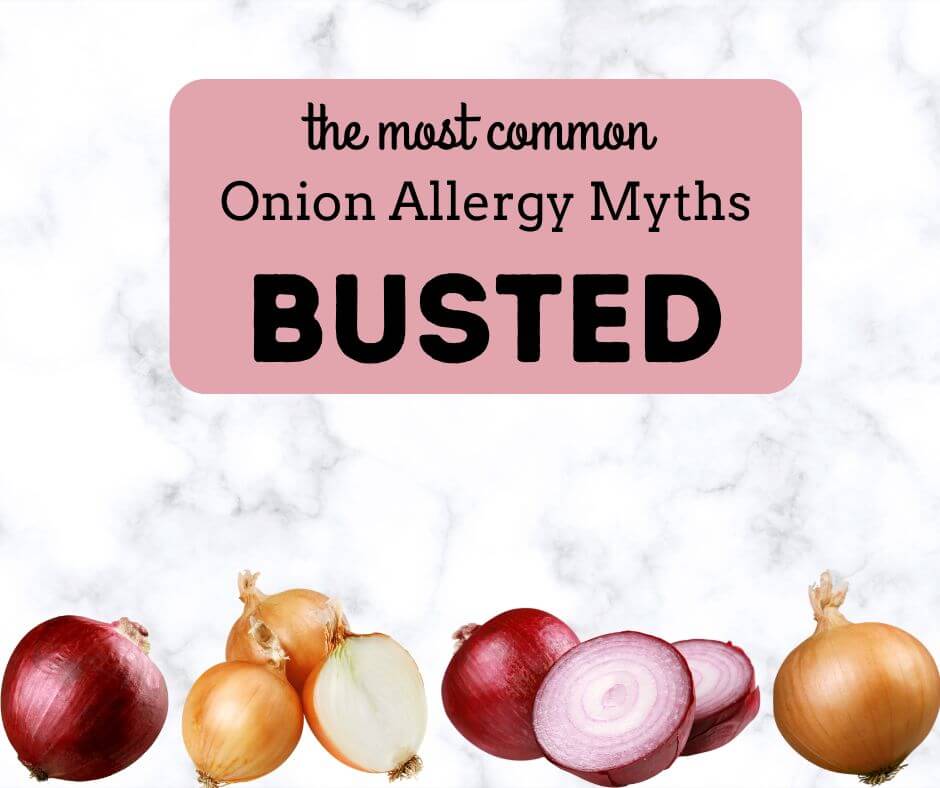Have you ever experienced the discomfort of sneezing uncontrollably or struggling with nasal congestion seemingly out of nowhere? These could be signs of an airborne onion allergy, a condition where onion allergens trigger allergic reactions when inhaled. Airborne onion allergy is the third part of my Surviving onion allergy guide so let’s dive deeper into the topic to understand its mechanisms, symptoms, diagnosis, and management strategies.
Check Out My Surviving Onion Allergy Guide:
What is an airborne allergy?
Probably you have experienced or know someone who is sneezing and has watery eyes when they come in contact with pollen or dust. It is an airborne allergy type, and millions of people in the world are affected. But, did you know that you can have the same reaction when you inhale food fumes?
Airborne allergies occur when allergens, substances that trigger allergic reactions, are inhaled into the body. Common airborne allergens can be pollen, dust mites, pet dander, and food.
Airborne allergy can cause a range of symptoms, from mild to severe reactions like anaphylaxis.
What is an onion airborne allergy?
Onion airborne allergy is a response of the immune system when it comes in contact with onion fumes. When a person inhales an onion smell, the immune system thinks that it is being under attack and starts defending itself.
Airborne onion allergy can be triggered by the smell of raw or cooked onions.
Mechanism of onion airborne allergy
When onion allergens are present in the air, they can enter the body through the nose and mouth. Upon inhalation, these allergens interact with the immune system, which may recognize them as harmful invaders. This recognition can trigger the release of histamine and other chemicals, leading to allergic symptoms.
How does an onion airborne allergy happen?
- Chopping and cooking: The act of chopping onions or subjecting them to heat during cooking causes the release of compound Allicin into the surrounding air.
- Inhalation: When these airborne particles are inhaled, they can trigger allergic reactions in individuals with airborne onion allergy.
Symptoms of onion airborne allergy
The symptoms of onion airborne allergy can vary from person to person. Some may experience milder symptoms, and some may experience severe symptoms and anaphylaxis.
Symptoms of onion airborne allergy can be divided into 3 groups: respiratory symptoms, nasal symptoms, and eye irritation.
Respiratory symptoms
- Sneezing
- Coughing
- Wheezing
- Difficulty breathing (in severe cases)
- Tightness in the chest (in severe cases)
- In rare but severe cases, anaphylaxis – a life-threatening allergic reaction requiring immediate medical attention.
Nasal symptoms
- Nasal congestion
- Runny nose
- Itchy nose
Eye irritation
- Itching
- Redness
- Tearing
Diagnosis of onion airborne allergy
Always consult a healthcare professional for proper diagnosis and personalized management of onion airborne allergy. They will conduct a thorough examination and recommend personalized treatment approaches.
Diagnosis typically involves:
- Medical History: The allergist will discuss your medical history, including past allergic reactions, symptoms, and any known allergies.
- Allergy Testing: Based on your medical history, the allergist may recommend one or both of the following tests:
- Skin Prick Test: A small amount of onion extract is applied to the skin and pricked to allow the allergen to enter. If you have an allergy, a raised bump or redness will develop after 15-20 minutes. This is a quick and painless test.
- Blood Test: Specific IgE blood tests measure the levels of antibodies produced in response to onion allergens. Elevated antibody levels suggest an allergic reaction. This test is safe and suitable for individuals with sensitive skin.
Treatment for onion airborne allergy
Treatment for onion airborne allergy should always be determined and supervised by a healthcare professional. They will assess your individual needs and recommend the most appropriate approach to manage your symptoms and reduce the frequency and severity of allergic reactions. The most important strategy when having an onion airborne allergy is to avoid exposure to onions. The following medications can help manage allergy symptoms but always use the medications you got from your allergist or GP. This list or guide is not a substitute for professional advice!
Treatment options from your healthcare provider may include:
It’s important to remember that:
- Treatment varies depending on the severity of the allergy and individual needs.
- This information is not intended as a substitute for professional medical advice. Always consult a healthcare professional for proper diagnosis and treatment of onion airborne allergy.
Managing onion airborne allergy through lifestyle adjustments
Living with onion airborne allergy can be challenging, but by taking proactive steps and making certain lifestyle adjustments, you can significantly reduce your exposure to allergens and manage your symptoms effectively.
Home strategies
Workplace adaptations
Social settings
Remember!
- Complete avoidance of onions, if possible, is the most effective way to manage airborne onion allergy.
- Consulting a healthcare professional for personalized guidance and treatment options is crucial.
- Support groups and online communities can offer valuable information and connections. The reason I started From Dora’s Kitchen food blog is to create a community of us who have allium allergy and to raise awareness about allium allergy. Join my newsletter list, follow me on social media, or send me a message.
Alternative ingredients and recipes
If you have an onion airborne allergy, finding alternative ingredients to replace onions in recipes can be helpful. Experimenting with different recipes and cooking techniques can help you to enjoy flavorful meals without compromising your health. For delicious recipes without onions check out my recipes here.
If you are searching for how to substitute onions in recipes, check out my guide about onion substitutes.
FAQ about onion airborne allergy
Can I be allergic to onion fumes?
Yes, individuals with onion allergy can have allergic reactions triggered by inhaling onion fumes. This occurs because these fumes contain allergens present in the onion itself. When inhaled, these allergens come into contact with the immune system in the nasal passages and respiratory tract, potentially triggering an allergic response.
Can onions cause nasal congestion?
Yes, onions contain compounds that can irritate the nasal passages and lead to symptoms like nasal congestion, especially in individuals with onion allergy.
What happens when you inhale onions?
When you inhale onions, the allergens present in the onions can come into contact with the nasal passages and respiratory tract, triggering allergic reactions.
Can smelling onions cause headaches?
In some cases, inhaling the strong odor of onions may trigger headaches or migraines in individuals sensitive to strong smells. However, this reaction is not necessarily indicative of an allergic response.
Can onion airborne allergy lead to anaphylaxis?
Yes, in severe cases, onion airborne allergy can lead to anaphylaxis, a life-threatening allergic reaction characterized by difficulty breathing, swelling of the throat, drop in blood pressure, and loss of consciousness. Anaphylaxis requires immediate medical attention!
Can children outgrow onion airborne allergies?
Some children may outgrow onion airborne allergies as they get older, although this varies from individual to individual. Regular follow-ups with an allergist can help monitor allergies and determine if they persist into adulthood.
Conclusion
Living with an onion airborne allergy can be challenging, but it doesn’t have to define you. By understanding your triggers, taking proactive steps, and accessing the right resources, you can effectively manage your symptoms and live a fulfilling life. Remember, you’re not alone in this – a supportive community awaits, and together, we can raise awareness and advocate for a better understanding of this allergy. Join me in creating a world where living with onion allergies is easier, more enjoyable, and less isolating. Explore my recipes, connect with others, and discover new ways to thrive without limitations. If you want to find out more about onion allergy check out my guide part 1, if you want to find out more about skin contact onion allergy click here, and for more information about onion as a food allergy click here.
Disclaimer: This overview of onion allergy is only for information purposes and it does not replace advice from your healthcare provider. All the information here is only to inform you, not to diagnose you. If you have any symptoms or you suspect that you have an onion allergy, consult your GP first.





